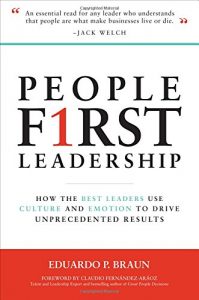Brand Book Bites from People First Leadership
– the book: People First Leadership: How the Best Leaders Use Culture and Emotion to Drive Unprecedented Results
– the brain: Eduardo Braun. In his role as the former Director of the World Business Forum, Eduardo has interviewed world leaders such as Bill Clinton, Rudy Giuliani, and Mikhail Gorbachev and business luminaries including Jack Welch, Tom Peters, and Herb Kelleher. This front-row seat to leadership in action has given Eduardo keen insight into what great leaders do.
– the best bits: Eduardo starts with an introduction to the role of culture relative to strategy and the importance of culture in driving individual and group success.
“Culture and strategy are not wholly independent variables; they are intimately interrelated. Culture is an important variable in the strategy implementation process — it affects what people do, how they act, how they compete.”
“…You need both the right strategy and a strong culture. However, if you recognize that culture can be a unique way of competing, you will discover that culture may in fact be the essence and heart of the strategy!”
The book then introduces the concept of the CEO as the Chief Emotions Officer.
“…Culture generates emotions, so, inasmuch as your role as a leader is to create and manage your company’s culture, your role as a leader is essentially to produce certain emotions. Leaders multiply results by creating cultures because cultures generate emotions, such as a sense of purpose, pride, and trust.”
“…It is the duty of a leader to understand that she can control and use certain stimuli to create the appropriate emotions that, in turn, increase performance at work.”
The bulk of the book examines the five roles that make up the job of the Chief Emotions Officer:
- Define and ignite the vision for the people in the organization.
- Recruit and take care of the people, and develop their talent and well-being as much as possible.
- Establish formal and informal systems for people to communicate and connect with each other
- Design a decision-making system that empowers people
- Develop and leverage the appropriate culture for the success of the organization
Some of the best bits of the book come from the many quotes from leaders that fill the pages. A few examples:
Rudy Giuliani, former mayor of New York City: “The first and most important principle of leadership is: ‘To be a leader, you have to have strong beliefs; you have to know what you believe; you have to know what you stand for.'”
Howard Schultz, CEO of Starbucks “We are in the business of people serving coffee, and not in the business of coffee serving people.”
Bill Clinton, former President of the United States: “My work as president could best be described as Chief Decision-Making Officer.”
Colin Powell, former U.S. Secretary of State and retired four-star general in the United States Army: “You must not hang onto your ego or your past success. Be passionate about what you think, but not so in love with your original idea that you ignore when it’s time to change it. If you want to be successful, you have to be ready to throw that which is no longer relevant overboard.”
Carly Fiorina, former CEO HP: “Run to the problem. So if you have a crisis, run to it. Don’t avoid it; don’t run away from it; don’t hide it; run to it. Run to it. Identify it. Acknowledge it. Deal with it.”
– the brand story: Because People First Leadership includes quotes and insights from leaders of some of the greatest organizations in the world, it conveys the outlines of many great brands. Southwest Airlines stood out to me because of clear connection between the leadership provided by Herb Kelleher, Cofounder, Chairman Emeritus, and Former CEO of the company and the positioning and success of the brand.
Kelleher explains it saying, “Given enough time and money, your competitors can duplicate almost everything you’ve got working for you. They can hire away some of your best people. They can reverse-engineer your processes. But the only thing they cannot duplicate is your culture. They can copy what we do, but not who we are or what we believe in, and without that, it’s not enough.”
Other quotes describe the unique culture he cultivated at Southwest. For example, he says, “I really think that our humanistic approach to our people was probably more essential than anything else, because we value them as individuals, not just as workers.”
And he explains the basis of Southwest’s culture: “Employees and my team come first; then comes the customer. I don’t think you can really honor, respect, and dignify your people if you say that the customer is always right…So, we don’t tolerate abuse of our employees by our customers. And our employees love that.”
Kelleher concludes, “I always thought that our esprit de corps, the attitude of our employees, was one of our biggest competitive advantages. You know, people like to be treated nice…and our people do that from the goodness of their hearts. And that is our advantage over other carriers.”
– the bottom line: If you are a leader or simply aspiring to be one, read this book. If all leaders did, more organizations would be successful, more people would be fulfilled, and more brands would be great.
Listen to my conversation with Eduardo to learn:
- what background P&G’s AG Lafley, Disney’s Michael Eisner, and other admired leaders attribute their success as leaders to
- how people first leadership relates to all people, even those not in formal leadership roles
- how culture and brand are interrelated
Podcast: Play in new window | Download
Learn more about and contact Eduardo at:
- his website: http://www.eduardo-braun.com/
related Brand Book Bites:



